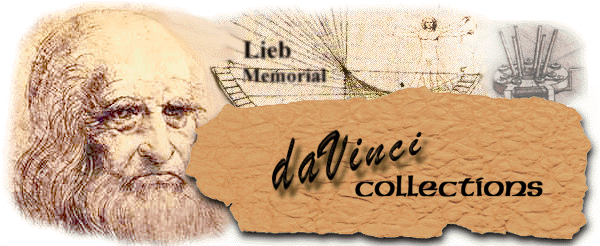of modern applications. By meshing the three cogged wheels of different diameters
to the same lantern wheel, three different speeds of rotation result, a principle used
in the transmission of the modern automobile.

Hydraulic Screw: By encasing a waterwheel, the water turbine was developed in
the early 19th century. Leondardo's horizontal impluse wheel, driven by the weight
of falling water, and his hydraulic screw were important steps in this direction. Like
the turbine, the hydraulic screw works with greater efficiency and a smaller water
supply than the older overshot or undershot type waterwheels.

Spindle-Shaped Hull: Intensive study of the action of water and the shapes of fish
led Leonardo to design hulls of greater stability and less friction &127;than the
round-bottomed vessels then generally in use, and somewhat similar to certain
sections of mod em racing hulls. Each side of the model illustrates a different design,
each developed from an experi mental and functional point of view similar to that of
modern engineering and marine architecture.

Double-Hulled Ship: If the outer hull of such a vessel were damaged, either by
enemy action in time of war, or by reefs or floating wreckage, the inner hull, still
intact, would keep the ship afloat. In more recent times both double hulls and the
division of the interior of the vessel into separate compartments by watertight
bulkheads have carried Leonardo's ideas toward still greater safety at sea.
Two Level Bridge: In reserving the upper level for pedestrians and the lower for
vehicles, Leonardo used the same idea for traffic control that appears in his plans
for an ideal city in which entire streets were thus restricted. The truss is similar to a
type used in bridges since the early 19th century.

Rotating Bridge: Designed to connect an island stronghold with the mainland, this
bridge could be swung across a stream or moat and back again by means of
windlasses. Swing bridges have proven to be practical only in relatively short spans.
Flying Machine: This early design called for a wooden framework and two
movable wings to be activated by the aviator who lies prone in the framework, and
works the wings by pulleys connected with stirrups moved with his feet, aided by
the windlass worked by his hands and arms. In later designs, often with more than a
single pair of wings, Leonardo has the operator standing upright.
Helicopter: Leonardo was fascinated with the form of the spiral which often
appears in nature, and is involved in the principle of the screw. His helicopter takes
the form of an aerial screw, following the example of a device earlier brought to
Europe from the Far East in the form of a children's toy. Of his design for the
helicopter he wrote, "If this instrument made with a screw be well made - that is to
say, made of linen of which the pores are stopped up with starch and be turned
swiftly, the said screw will make its spiral in the air and it will rise high."

Parachute: "If a man have a tent made of linen of which the apertures have all been
stopped up, and it be twelve braccia across and twelve in depth," Leonardo wrote,
"he will be able to throw himself down from any great height without suffering any
injury."
Scaling Ladder: To reach the top of the wall of an enemy fortress, Leonardo
designed this scaling ladder in a form similar to that employed today in fire-fighting
apparatus. It is elevated and lowered by means of the crank and the large toothed
gear.
Triple-Tier Machine Gun: There are eleven barrels in each tier. While one is
fired, another tier is loaded, and the third cools. This weapon, like others Leonardo
designed, shows him constantly attempting to achieve greater fire power.
Military Tank: Leonardo designed this ancestral version of the tank to carry
heavy fire power and be driven by men working the enclosed wheels with cranks.
Its turtle-like cover was intended to deflect enemy fire. "These," he wrote, "take the place of the elephants. One may tilt with them. One may hold bellows in them to
spread terror among the horses of the enemy, and one may put carabineers them to
break up every company."






